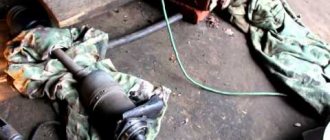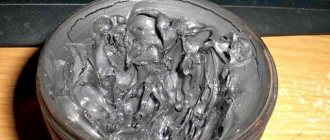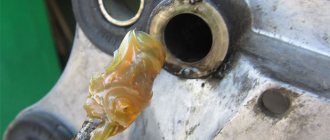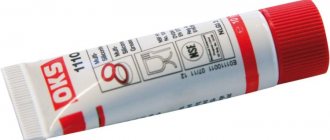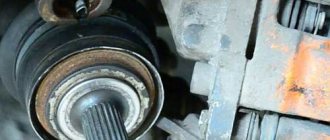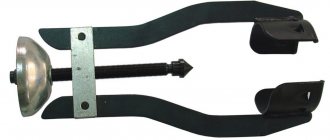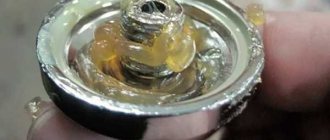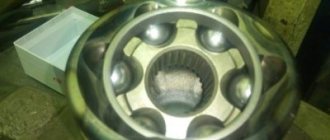The constant velocity joint (or CV joint for short) is involved in transmitting torque from the gearbox to the drive wheel hub. That is, this node is a priori heavily loaded. Therefore, CV joints require the use of special lubricants that can provide reliable protection of contacting parts operating under heavy loads. What lubricant is best to use for CV joints will be discussed below.
CV joint lubrication
Grease for CV joints ensures normal operation of the constant velocity joint, reduces the level of friction, increases the efficiency of the mechanism and prevents corrosion on the surface of individual parts of the joint. Many drivers are interested in a natural question - what lubricant should be used for the CV joint ?
We have collected for you information and comparative characteristics of lubricants presented in stores, which we bring to your attention. The material also provides practical information on their use, as well as reviews and personal experience of using 6 popular lubricants by some car owners. You will learn about such aspects
What lubricants should not be used?
No matter what convincing salespeople in specialized stores tell you, never use the following for CV joints:
- calcium/sodium-based grease compositions - they are not suitable for lubrication of highly loaded components, deviation from this recommendation is fraught with accelerated spread of corrosion and a reduction in the service life of the hinge to 15-30 thousand km;
- graphite lubricant - it is not thermally stable, therefore, when used in CV joints, it reduces their service life to 20-25 thousand km;
- hydrocarbon compounds (including technical petroleum jelly) - again, due to instability to high temperatures, are completely washed out from the unit after just a few kilometers, which means the CV joint will work dry, and the longer this happens, the faster the part will need replacement;
- mineral lubricants based on iron/zinc - do not withstand increased loads and, like the previous compounds from this list, contribute to accelerated wear of the constant velocity joint.
What is a CV joint, its functions and types
Before we move on to talking directly about lubricants, let’s take a closer look at CV joints. This will be useful in order to find out what properties a lubricant for a “grenade”, as the CV joint is popularly called, should have, and what composition to use in a given case. The purpose of the hinge is to transmit torque from one axis to another, provided that they are at an angle to each other. This value can be up to 70°.
In the process of their evolution, the following types of CV joints were invented:
- Ball . They are one of the most common, in particular their variant “Rtseppa-Lebro”.
- Tripod . They are often used in the domestic automotive industry as internal CV joints (that is, those installed on the power drive side).
A feature of any angular velocity joint is high shock loads. They occur when starting a car, climbing hills, driving on uneven roads, and so on. With the help of special CV joint lubricants, all negative consequences can be neutralized.
Properties of lubricants for constant velocity joints
Due to the difficult operating conditions of the mentioned joints, CV joint lubrication is designed to protect the mechanism from negative factors and provide:
- increasing the coefficient of friction of the internal parts of the hinge;
- minimizing wear of individual parts of the CV joint;
- reduction of mechanical load on the components of the assembly;
- protection of the surfaces of metal parts from corrosion;
- neutral reaction with rubber joint seals (boots, gaskets) so as not to damage them;
- water-repellent functions;
- durability of use.
Based on the requirements listed above, the lubricant for the outer or inner CV joint must have the following characteristics:
- a wide temperature range, allowing the composition to be used at critical temperatures (modern CV joint greases are capable of operating at temperatures from -40°C to +140°C and above, this range depends on the specific brand of lubricant);
- high degree of adhesion (the ability to adhere to the working surface of the mechanism, simply put, stickiness);
- mechanical and physico-chemical stability of the composition, ensuring constant performance characteristics of the lubricant under any operating conditions;
- high anti-scuff properties, ensuring the proper level of sliding of lubricated working surfaces.
Thus, the characteristics of the lubricant for CV joints must fully comply with the given list. Currently, the industry produces several types of such compositions.
Types of lubricants for CV joints
Lubricants are produced based on various chemical compositions. Let us list and characterize the types currently used.
LM47 lubricant for CV joints with molybdenum disulfide
Lithium CV joint greases
These are the oldest lubricants that began to be used immediately after the invention of the hinge itself. They are based on lithium soap and various thickeners. Depending on the base oil used, lubricants can range in color from light yellow to light brown. They are well suited for use at medium to high temperatures . However, at low temperatures they lose their viscosity , so the level of protection of the mechanism is significantly reduced. It is even possible for the hinges to tap during extreme cold.
CV joint grease with molybdenum
With the advancement of technology, the use of lithium greases has become largely ineffective. Therefore, the chemical industry has developed more modern lubricants based on lithium soap, but with the addition of molybdenum disulfide. As for the lubricating properties, they are approximately the same as those of lithium analogues. However, a feature of molybdenum lubricants is their high anti-corrosion properties . This became possible thanks to the use of metal salts in their composition, which replaced some of the acids. Such compositions are absolutely safe for rubber and plastic, from which some CV joint parts are made, in particular the boot.
A significant disadvantage of molybdenum-based lubricants is their fear of moisture . That is, if even a small amount of it gets under the boot, the lubricant with molybdenum turns into an abrasive with the ensuing consequences (damage to the internal parts of the CV joint). Therefore, when using molybdenum grease, it is necessary to regularly check the condition of the boots on the CV joint body, that is, its tightness.
Popular products from this series in our country are CV joint lubricants , LM47 and others. We will talk about their advantages, disadvantages, and comparative characteristics below.
Barium grease ShRB-4
Barium lubricants
This type of lubricant is the most modern and technologically advanced today. Lubricants have excellent performance characteristics, chemical resistance, are not afraid of moisture and do not interact with polymers. They can be used as a lubricant for the outer and inner CV joints (tripod).
The disadvantage of barium lubricants is that their decrease at low temperatures . Therefore, it is recommended to replace it after every winter. In addition, due to the complexity and manufacturability of production, the price of barium lubricants is higher than that of lithium or molybdenum analogues. A popular domestic lubricant of this type is ShRB-4.
What lubricants should not be used
CV joint is a mechanism that works in difficult conditions. Therefore, to lubricate it, you cannot use any compounds that come to hand. In particular, CV joints cannot be lubricated :
- graphite lubricant;
- technical petroleum jelly;
- “Grease 158”;
- various hydrocarbon compositions;
- compositions based on sodium or calcium;
- compositions based on iron and zinc.
Let's summarize
Lubrication for the CV joint is vital, so monitoring its availability and condition is the task of every conscious motorist. When asking which lubricant is best for CV joints , you should follow the recommendations of the manufacturer of your car, and also take into account the composition of the anthers and other “rubber bands” that may be subject to destruction. In my opinion, the “golden mean”, that is, the optimal option, can be considered lithium variate, provided that the anthers and other polymers are “not afraid” of this type of lubricant. If this option is contraindicated for you, pay attention to the second option - molybdenum. They are not inferior in quality to the previous ones, but require constant monitoring and do not tolerate moisture, so make sure that the anthers are intact. The third option is suitable for those who live in warm climates where there are no harsh winters, since barium CV joint lubricants do not tolerate low temperatures. If finances allow for regular seasonal replacement of barium grease, then this option will be ideal in terms of characteristics and useful properties.
When going to the store, I advise you to pay attention to the following manufacturers: Liqui Moly, BP, ESSO, Mobil and Texaco, as well as: Litol, CV joint-4, ShRB-4 and Fiol. The second group is represented by a domestic manufacturer, which is not inferior in quality to foreign analogues and is significantly cheaper.
That's all I have, I hope the above will be enough for you to make your choice, I hope it will be the right one! All the best and see you again on the pages of Question Auto.
Relevant: How to lubricate threaded connections so that they do not rust and can be easily unscrewed? There's an answer!
Use of lubricants at low temperatures
Many car owners living in the northern regions of our country are interested in the question of choosing CV joint lubricants that would not freeze in severe frosts (for example, -50°C...-40°C). The decision must be made based on the information provided by the manufacturer. This is very important, not only for lubrication of CV joints, but also for other oils and fluids used in cars in the north.
According to reviews from car owners living in the far north or close to them, domestic lubricants “CV joint-4” and RAVENOL Mehrzweckfett mit MoS-2 . However, we will touch on the choice of lubricants a little later.
Replacing lubricant in CV joints
The procedure for replacing lubricant in constant velocity joints, as a rule, does not cause difficulties even for inexperienced car enthusiasts. First of all, you will need to remove the CV joint from your car. The sequence of actions will directly depend on the design and structure of the machine. Therefore, it is impossible to give specific recommendations. You should also know that hinges can be internal or external. The principle of their operation is radically different. Without going into details of the designs, it is worth saying that the basis of the outer CV joint is balls, and the basis of the inner CV joint (tripod) is rollers or needle bearings. The inner CV joint allows large axial movements. Different lubricants are used to lubricate the internal and external hinges . We will carry out an example of replacement using a tripoid CV joint, as the most popular option.
When the CV joint is in your hands, the immediate replacement procedure is performed in accordance with the following algorithm:
Lubricant level for CV joint in the “glass”
- Disassembling the case . Often the body is fastened with two retaining rings (rolled). Accordingly, in order to disassemble it, it is necessary to remove these rings using a flat-blade screwdriver.
- Removing the boot and sealing ring. After performing this simple procedure, it is necessary to check the integrity of the boot. If necessary, buy a new one for future replacement.
- Next, you need to remove all the internal mechanisms of the hinge and disassemble them. Usually the tripod itself is held on the axle shaft by a retaining ring, which must be removed to dismantle it using a screwdriver.
- Thoroughly wash all internal parts (tripod, rollers, axle shaft) in gasoline or solvent to remove old grease. The insides of the body (glass) also need to be cleaned of it.
- Place a certain amount of grease (approximately 90 grams, but this value differs for different CV joints) into a glass. We will deal with the issue of choosing a lubricant for the tripod a little lower.
- Place the tripod on the axis in the glass, that is, at your workplace.
- Add the remaining amount of lubricant on top of the installed tripod (usually tripods use about 120.150 grams of lubricant in total). Try to apply the lubricant evenly by moving the tripod axis in the body.
- After you have applied the required amount of lubricant for the tripoid CV joint, you can begin assembly, which is done in the reverse order of dismantling. Before tightening the rings or clamps, lubricate the grooves for them with “Litol-24” or some similar lubricant.
Replacing the lubricant on the outer CV joint of the VAZ 2108-2115
Replacing the lubricant on the inner CV joint
As you can see, the replacement procedure is simple, and any car owner with basic plumbing skills can handle it. The main question that needs to be answered before performing this procedure is which CV joint lubricant is better and why? In the next section we will try to answer it.
Application of lubricants for CV joints
Due to the difference in the design of internal and external constant velocity joints, technologists recommend using different lubricants for them. In particular, the following brands of lubricants are used for internal CV joints :
Lubricants for internal CV joints
- Mobil SHC Polyrex 005 (for Tripod bearings);
- Slipkote Polyurea CV Joint Grease;
- Castrol Optitemp BT 1 LF;
- BP Energrease LS-EP2;
- Chevron Ulti-Plex Synthetic Grease EP NLGI 1.5;
- VAG G052186A3;
- Chevron Delo Greases EP;
- Mobil Mobilgrease XHP 222.
for external CV joints :
Lubricant for outer CV joints
- Liqui Moly LM 47 Langzeitfett + MoS2;
- Very Lube LITHIUM LUBRICANT FOR CV joints MoS2;
- Mobil Mobilgrease special NLGI 2;
- BP Energrease L21M;
- XADO CV joint;
- Chevron SRI Grease NLGI 2;
- Mobil Mobilgrease XHP 222;
- CV joint-4.
Lubricants made with polyurea
Recently, lubricants developed on the basis of polyurea (synthetic polymers that contain urea) have attracted serious interest from car enthusiasts. When such compounds get inside the mechanism, they form a special protective film that performs all the necessary protective functions. An example of such compounds is the popular Slipkote® Polyurea CV Joint, which is used for application to internal CV joints and other critical machinery parts.
Among the domestic lubricants, we can highlight the new composition “MS-CV joint tripod”, which is characterized by universal use and can withstand up to +160 degrees Celsius. The composition is developed on the basis of synthetic oils.
The best lubricant for CV joints
We found reviews from real consumers on the Internet about common lubricants for CV joints, and then analyzed them. We hope that this information will be useful to you and will help answer the question - which lubricant is best to use for CV joints. Reviews are presented in the form of tables, the sequence of mentions indicates their popularity, from more to less popular . Thus, we have the TOP 5 best lubricants for CV joints:
Domestic lubricant CV joint-4
CV joint-4 . Lubricant produced by several Russian enterprises. It was invented for use in the first Soviet SUV, the VAZ-2121 Niva. However, later it began to be used in front-wheel drive VAZs. In addition to being used in ball bearings of outer CV joints, the grease can also be used to lubricate carburetor parts, telescopic struts, and clutch bearings. CV joint-4 is a mineral lubricant based on lithium hydroxystearate. Its temperature characteristics: operating temperature - from -40°C to +120°C, dropping temperature - +190°C. The price of a tube weighing 100 grams is $1.2, and a tube weighing 250 grams is $2.3. Catalog number: OIL RIGHT 6067.
Types of CV joint lubricants for your car
What is the best lubricant for CV joints and why is it needed? Front-wheel drive cars have a number of advantages over rear-wheel drive cars. The production of front-wheel drive cars is simpler; they are resistant to skidding on wet and snowy road surfaces. But in addition to the advantages, these cars also have disadvantages, these include the use of a constant velocity joint in the car drive, which ensures confident movement.
The CV joint is a part that contributes to rapid wear of the transmission. To extend life, it is necessary to use a specialized lubricant for the outer and inner CV joints, which increases the wear resistance of the CV joint and transmission components. Today there are a huge number of different lubricants and car owners have to rack their brains over the question of which lubricant option will best lubricate CV joints and their joints before choosing the right one.
What functions does a lubricant perform?
Motorists know that lubricants used in car components and joints not only reduce friction and prevent premature wear of car parts.
But they also reduce the load on the parts, as a result of which the parts rotate freely and the car continues to move without friction or load. CV joint lubrication allows you to reduce fuel costs and losses in transmission operation. A very important property is to prevent the spread of corrosion. It is during corrosion that the operation of CV joints is accompanied by the appearance of an unpleasant knocking noise, which intensifies when the steering wheel is turned and torque is not transmitted effectively. To prevent CV joints from getting dirty, boots are used. It is important to prevent grease from getting on the boots; they are made of rubber or plastic, which is eaten away upon contact with grease.
What characteristics should a lubricant for internal CV joints have?
It is important to clearly understand that CV joints operate in very harsh conditions, associated with the constant occurrence of various force moments. Elevated temperature has a particularly negative effect. In order for the CV joint to work for a long time and not break, it is important to lubricate the part correctly and with a composition that will meet all important parameters.
Here are some tips for choosing the right lubricant:
- Since the required composition is placed in the assembly and completely sealed using special anthers, you should choose compositions that are completely neutral to plastic and rubber.
- You should not give preference to lubricants containing solid particles, since they acquire the consistency of an abrasive material and subsequently lead to the complete destruction of the functional components of the car.
- You should absolutely not use lubricant that you just happen to have on hand, as this will not provide long-term protection for the joints in the future. You should not use graphite lubricants, which quickly damage CV joints.
- The product must be able to withstand significant temperatures, since only in this case will it be able to fulfill its purpose for a long time.
And lastly, the grossest violation is the use of lubricants designed exclusively for ball joints in relation to needle roller mechanisms. The compounds can harm the mechanism if used for other purposes. Details about lubricating compounds can be found in the video:
When does the CV joint lubricant change?
The lubricant is replaced in the following cases:
- torn boot and its replacement;
- replacing the angular velocity adjustment hinge;
- CV joint operation for more than 5 years;
- mileage over 100 thousand kilometers.
You should not apply a large amount of lubricant, this will not provide better protection, but will only increase the likelihood of damaging the anthers. There should be enough lubricant so that the part is completely lubricated and no grease drips from it.
How much grease should I fill into the CV joint? It all depends on whether it is indoor or outdoor. For an internal CV joint, 100-110 grams is enough, and for an external CV joint, 70-80 grams.
Nominal quantity
How much grease should I put in the CV joint? The question interests everyone who plans to do the replacement work themselves. Regardless of the type of hinge, it is recommended to use no more than 150 grams and no less than 120. As already said, more is possible, because everything that seems unnecessary will be squeezed out of the system. If you put less, the likelihood that the CV joint will fail ahead of schedule increases significantly. If it fails, a characteristic crunching sound will be heard when turning. If this happens, you need to change it immediately, because there may be problems with the entire chassis system. You can see how to lubricate the CV joint in the video below.
Some car enthusiasts do not know the names of car components. Therefore, during the repair process or during communication with service specialists, difficulties may arise. CV joint is a joint of angular velocity.
There are two types:
- external - for rotating the wheel hubs directly;
- internal - to transmit torque from the engine to the wheels.
Types of lubricants
Along with the question: which CV joint is better, motorists are faced with the problem of choosing a lubricant. There are many different lubricants for caring for CV joints and each has its own advantages and disadvantages. Here we will consider only those that have proven themselves and are considered most suitable.
Lithium based greases
The most common lubricants are lithium foam lubricants in organic acid.
These lubricants are yellowish in color and a little thick. In the cold they thicken even more, as a result of which spreading them on the part becomes a little problematic. This problem makes itself felt at sub-zero temperatures at the beginning of driving - you can hear the tapping of the CV joints and suspension. When all the mechanisms warm up, the car's operation is improved. Such lubricants reduce friction well and reduce the load on components by up to 10 times. The big advantage is the neutralization of trapped dust and the ability to prevent moisture from reaching the parts. Another feature of lithium greases is that they are fully compatible with polymers that are installed on CV joints, with the exception of some hard plastics that are present on modern cars.
The disadvantage of lithium greases is that most of them have poor corrosion resistance. This is what you need to pay attention to first when choosing this type of lubricant.
Lithium-based lubricants can be used such as Litol-24, Renolit, Xado. These lubricants have already proven themselves on the market and have the most suitable properties.
Molybdenum disulfide based lubricants
Due to the fact that the lithium option is not suitable for all cars, engineers had to look for a way out.
The solution to the problem was a lubricant to which molybdenum disulfide was added. Thanks to this connection, the lubricant for CV joints has acquired high corrosion resistance. In addition, the amount of acid in the lubricant is reduced, which reduces the level of interaction with solid polymers. Thanks to this, it became possible to use such a lubricant on any modern car. If we consider resistance to friction, then in this feature lubricants based on lithium and molybdenum disulfide are almost the same. But still, there is a big drawback in the molybdenum disulfide product. The lubricant completely loses its properties after water gets under the damaged boot. To prevent this from happening, you need to inspect the condition of the anthers at least once a month. You should also look under the car after heavy impacts on the suspension and off-road driving.
Such lubricants are produced by a variety of manufacturers. Shrus-4 lubricant, produced domestically, is not inferior to analogues from other countries, it works no worse. From foreign ones, you can use such lubricants as Mobil, BP, Liqui Moly, Esso.
Barium based lubricants
Recently, scientists have created many different lubricants for CV joints, but only one type combines the advantages of lithium and molybdenum without their disadvantages - barium lubricants.
The main advantage of such lubricants is their high resistance to moisture. For example, if the boot ruptures, the barium-based lubricant can not be changed until a lot of dirt has accumulated in it. Equally important is that such barium grease protects CV joints from all types of corrosion and does not dissolve boots made of any polymers. The only thing that this type of lubricant cannot boast of is the price and low resistance to negative temperatures. Barium-based lubricants are much more expensive than lithium and molybdenum lubricants due to the complexity of their manufacture and are much less common.
On the market you can find only one domestically produced barium-based product - ShRB-4.
Lubricant for tripod CV joint
02.12.2015
Good afternoon Today I would like to answer numerous questions from forum members about why functionally and structurally similar constant velocity joints (CV joints) of car axles need to be lubricated with different lubricants and why a single lubricant cannot be used to lubricate them.
Let's take a look at the design of these units together.
So, the outer Rzepp constant velocity joint - named after the inventor Alfred Rzepp - consists of only four parts: a spherical bowl with six grooves and a driven shaft, an inner spherical race with counter grooves, a separator and six balls that transmit torque between the races and the axle shafts . A feature of the operation of such a hinge is the high specific pressures in the contact area of the balls and grooves, which greatly limit the resource of this unit and predetermine the type of lubricant with special protection under conditions of boundary friction and high contact pressures. For these purposes, lubricants based on mineral oil thickened with a lithium thickener and containing the addition of molybdenum disulfide (MoS 2 ) are traditionally used. Molybdenum disulfide protects the working parts of the outer CV joint from wear and guarantees its long service life, comparable to the service life of the car. Thus, lubricants without solid additives are not able to provide an acceptable service life of the Rzepp CV joint and, therefore, we lubricate the outer CV joints with lubricants containing 3% molybdenum disulfide. The most common lubricant with molybdenum disulfide in Russia is ARGO Elit M EP2 lubricant. In terms of performance properties, Elit M is not inferior to such common foreign lubricants as Mobilgrease Special.
Let us now consider the design of the internal CV joint of the “Tripod” type and the features of its operation.
The Tripod CV joint also consists of four main parts: a sleeve with longitudinal grooves and a drive shaft, a three-spike race with three needle bearings and a driven shaft. The design of this CV joint is also based on the principle of operation of the Rzepp joint, but the features of its operation are elevated temperatures due to the proximity of the engine, as well as the absence of high specific pressures, which is ensured by the use of needle bearings in the joint studs. As you know, a needle bearing, being a type of roller bearing, requires the use of “clean” lubricant with anti-wear and extreme pressure properties without solid lubricating additives. In this case, solid additives to the internal CV joint are contraindicated, as they can form wedges between the rolling elements and cause increased wear of the unit. Thus, the nature of friction in a Tripod-type joint resembles a needle bearing on a driveshaft spider. And in this case, I want to warn against using blue automotive lubricant “158”. The fact is that “158” grease is made with a mixed lithium-potassium thickener, which remains operational at temperatures no more than 110⁰C, while the internal CV joint in the immediate vicinity of the engine can heat up to 140-160⁰C. At these temperatures, a lubricant with a lithium complex thickener or polyurea is required. Moreover, lubricant based on a synthetic polyurea complex - polyurea - is considered lifelong and is usually included in new CV joints supplied to the conveyors of automobile factories. In auto repair shops, the use of polyurea lubricants is due to the need to add fresh lubricant to a new CV joint in the event of replacing this unit during car repairs. I will make a reservation that the lifetime of polyurea lubricants means that their service life is commensurate with the service life of the lubricated unit, but does not at all mean the eternity of these units.
What does the Russian market for lubricants with a synthetic polyurea thickener look like?
On the Russian market, polyurea lubricants are represented by all global manufacturers and, of course, Mobil Polyrex EM lubricant from ExxonMobil. They occupy the largest niche of this product. What do Russian manufacturers offer? A new product in this type of lubricant on the domestic market is the TermoLux P150 lubricant from the Russian company ARGO. Let's take a closer look at what benefits we are offered to get from this lubricant.
First of all, the polyurea thickener and base oil with a viscosity of 145 cSt at 40⁰C determine its use in the already mentioned tripoidal CV joint of a passenger car as lifelong, turning the CV joint into a maintenance-free unit. ARGO TermoLux P150 is an ideal lubricant for internal CV joints. This is its most important and widespread application and purpose.
By the way, here are the technical characteristics of this lubricant in comparison with Mobil Polyrex EM.
ARGO TermoLux P 150
| Index | Method | ARGO TermoLux P150 EP2 | Mobile Polyrex EM |
| Thickener | — | Polyurea | Polyurea |
| Operating temperature range, ºС | — | -20..+150 | -20..+150 |
| Classification of lubricants | DIN 51502, DIN 51825 | K2P-20 | K2P-20 |
| Grease color | Visually | Blue | Blue |
| NLGI consistency class | DIN 51818 | 2 | 2 |
| Penetration 0.1 mm | DIN ISO 2137 | 265-295 | 265-295 |
| Base oil viscosity at 40ºС, mm2/s | DIN 51562-1 | 145 | 115 |
| Dropping temperature, ºС | DIN ISO 2176 | 260 | 260 |
| Welding load, N | DIN 51350 | 4900 | n.d. |
| Corrosion test | ASTM D 1743 | Passes | n.d. |
Noteworthy is the high welding load of 4900 N, which guarantees the highest protection of parts against scuffing at the highest overloads. This best helps to increase the service life of the needle bearings of the tripod CV joint (internal “grenade”) of a front-wheel drive vehicle. The combination of the antioxidant properties of the thickener and high extreme pressure properties determine the “lifetime” of our CV joint and the lubricant in it.
That’s, in fact, all that was important for us to find out about the features of the tripod CV joint and lubricants for it.
With that, I say goodbye until we meet again!
How to choose a lubricant
Grease lubricating CV joints has a different appearance. Considering all the features and internal set of characteristics of lubricants, the most suitable option today is lubricants based on molybdenum disulfide. A good option, suitable for all cars, minimizing friction in the components and resistant to corrosion, with minimal impact on the boot. By lubricating each CV joint unit, you will extend its life. But still, when choosing a lubricant, you should follow the recommendations in the instructions for your car.
How to choose a lubricant for a CV joint?
The constant velocity joint (CV joint) is an important part used in front-wheel drive and all-wheel drive vehicles. The CV joint transmits torque from the transmission to the wheels, while being subjected to serious shock loads; therefore, special lubricant is necessary: it protects CV joints from premature wear and corrosion.
Constant velocity joints come in a variety of designs, but there are two main types used in the modern automotive industry. The first type is the classic Rzeppa-Lebro joint with 6 balls. This type of CV joint is now most common as external wheel drives of front-wheel drive passenger cars and off-road all-wheel drive vehicles, less often used as internal or cardan joints. The second type is a tripod joint, which has smaller rotation angles, but allows higher speeds and axial displacements, and is used mainly as internal joints in passenger cars. These two types of joints require two completely different types of lubrication.
The Rzepp ball joint, due to very significant contact pressures, requires a lubricant, depending on the load, containing from 3% to 5% molybdenum disulfide. The lubricant is made on a mineral base, lithium complex soap is used as a thickener, and EP additives are often added to increase load-bearing capacity. The service life of such a hinge and the lubricant itself is very long and approaches the service life of the car itself, if not for the rubber covers. Quite often, covers tear due to mechanical stress. If the rupture of the cover can be quickly determined, then it is enough to simply change the cover and lubricant; if not, then the hinge itself must be replaced. Most manufacturers supply spare parts with covers, along with CV joint lubricant in an anonymous plastic bag, often in insufficient quantities. The CV joint may require from 40 to 90 grams of lubricant. Lubricants for CV joints from different manufacturers can differ significantly from each other, both in price and in properties, and you should not think that the spare parts are supplied with products of the highest quality. That is why Liqui Moly offers a special lubricant for CV joints LM47 Langzeitfett + MoS2 in separate packages of 100 and 400 g. LM47 is significantly superior to standard lubricants and is suitable for the highest loads and speeds, and contains additional (except for molybdenum disulfide) anti-seize additives based on zinc-phosphorus compounds.
Tripod-type joints, due to the increased temperature (proximity to the gearbox and design feature), require high-temperature lubricant without solid inclusions, and the penetration (viscosity) of such a lubricant is slightly lower than that of classic lubricant for CV joints. Tripods use a lubricant with a polyurethane thickener, first class penetration, an upper temperature range of up to +180°C and a mandatory EP complex.
The correct choice of lubricant for constant velocity joints is the key to a long service life, as well as a comfortable and safe ride.
Top three
Now we will present three options that are most popular today. There will also be an opportunity to familiarize yourself with the immediate parameters.
3. Mobil Mobilgrease XHP 222. This is one of the best options for a tripod. Has a lithium base. As for the reviews, they do not so much say that the lubricant is good and of high quality, but that it is affordable. Its cost is approximately 300-450 rubles, depending on the region. It operates at a maximum temperature of 175 degrees Celsius. Frequent replacement is not required. Excellent moisture tolerance. It is used not only in cars, but also in larger industries.
2. Very Lube. You can buy it for only 200-250 rubles. The temperature range for long-term use is from - 25 to + 130 degrees, for short-term use it reaches + 150 Celsius. Used for external constant velocity joints. Looking at user reviews, we can conclude that the lubricant is quite good. Significantly increases the service life of the part. Optimal ratio of quality and price. Among the disadvantages, poor moisture tolerance is noted. This can play an important role if you often have to drive on wet roads.
1. CV joint lubrication 4. Main characteristics: water-resistant, mechanically stable, practically does not evaporate, temperature range - from - 40 to + 120 degrees. The composition includes antifriction additives. The base is petroleum oil. Used on most domestic cars. Its shelf life is no more than five years. Can be used in all friction units. There are no negative opinions about this lubricant. According to users, it copes well with all loads and is not at all expensive. Its price is 150 rubles. It is rightfully considered one of the best options for CV joints. You can even use it on foreign cars.
How often do you change the lubricant?
Lubrication is provided at the factory for the entire service life of the joint, but no one is immune from surprises. The rubber or plastic CV joint boot can tear due to contact with foreign objects or overheating. Then dirt and water inevitably get into the hinge. If the problem is not detected in time, the expensive hinge will have to be replaced and, accordingly, fresh lubricant must be added to the new part. If you regularly check the CV joint covers, then it is enough to simply replace the cover itself and, of course, the lubricant.
